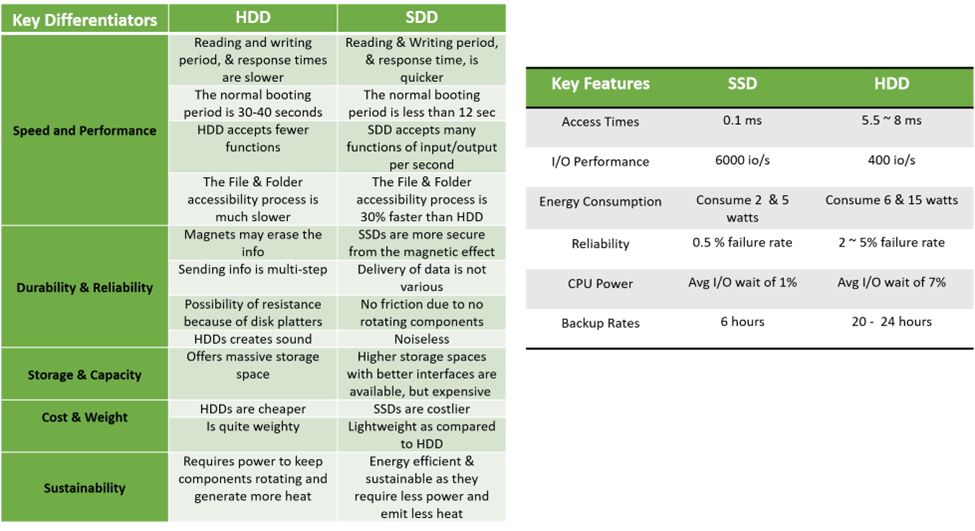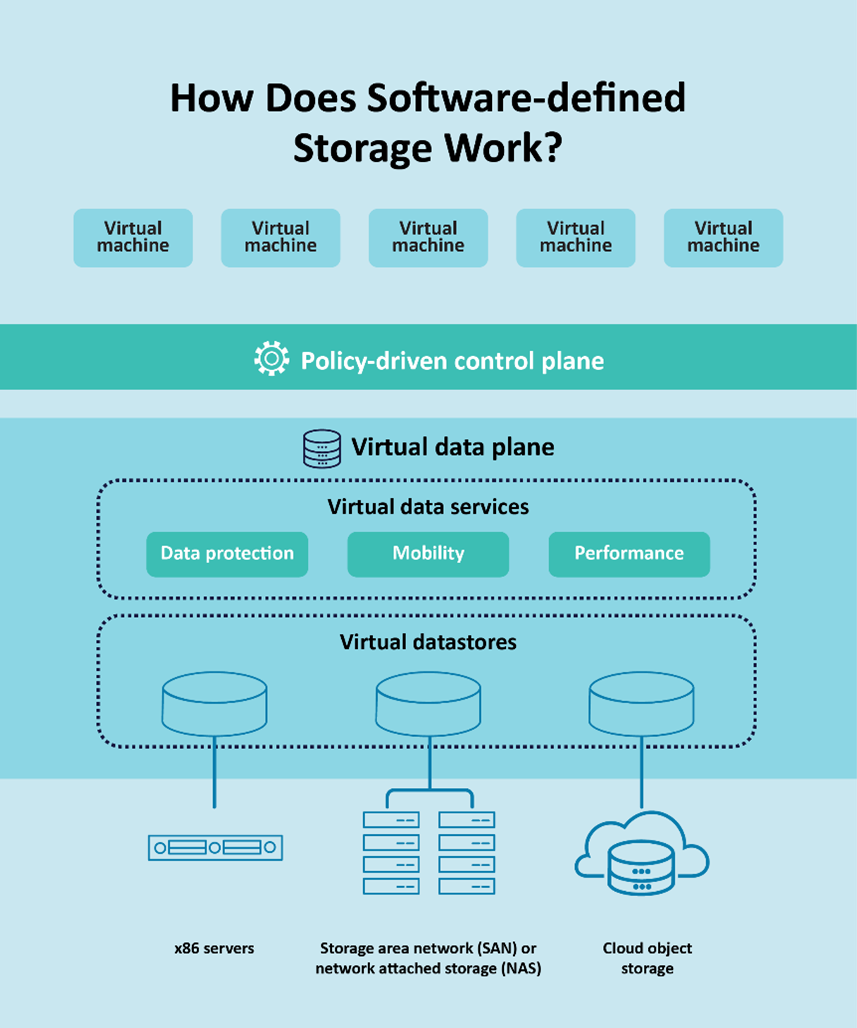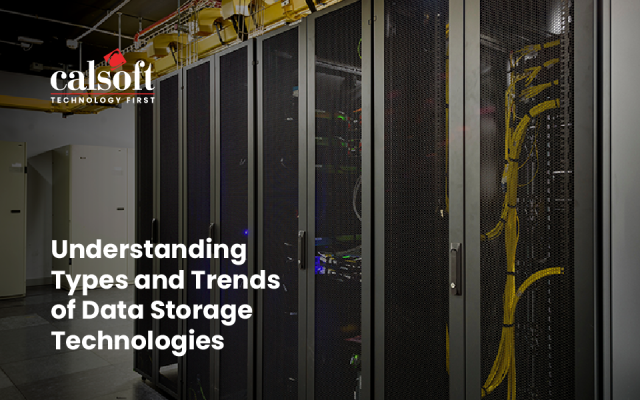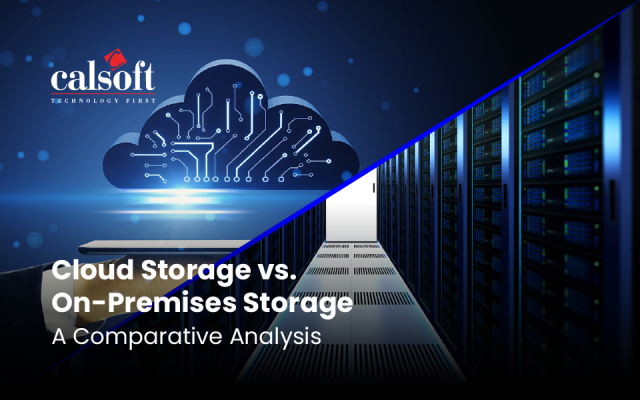Data is essential for success. Businesses cannot afford to lose or put data at stake in any situation. Data being one of the crucial assets for success, there have been several researches conducted to understand different facets of this element. Statista states that by 2025 global data creation is projected to go beyond 180 Zettabytes. Considering these numbers, we cannot deny that data is growing in leaps and bounds. Enterprises today are relying on data for several reasons. From making informed decisions to delivering customer satisfaction, data plays a crucial role in the journey to success.
But what are the most suitable storage solutions for enterprises to store all this data?
Well, this question can have different ramifications, as there are a range of options like SSDs, HDDs, and cloud storage in this realm. However, the choice broadly depends on what the business needs. Remember, each storage option offers distinct benefits and considerations related to security, scalability, accessibility, and cost. Therefore, banking on the right storage solution is crucial to effectively manage and make the best use of the growing volume of data for business insights and innovation. We have carefully curated this blog to share in-depth information and insights about the evolution of storage solutions. Read on to understand different types, their characteristics, and more importantly factors to consider before zeroing down on the solution.
A Brief Introduction to Data Storage Options
Understanding data storage requires careful consideration and research, especially when it comes to Solid-State Drives (SSDs) and Cloud Storage. These technologies offer incredible speed, scalability, and flexibility. SSDs are improving data center performance by replacing traditional HDDs. Unlike HDDs, which use magnetic storage and moving parts, SSDs utilize flash memory, enhancing speed and durability. Cloud Storage has revolutionized data management, offering secure remote storage and flexible scalability, reducing the need for costly hardware upgrades.
Storage Solutions: HDD and SSD
NAND flash memory, found in SSDs, revolutionized the definition of storage in the early 2000s. Initially leveraged for specialized uses like military and industry, it currently is the go-to option for high-performance storage in laptops, desktops, and data centers. Developments in NAND technology have radically enhanced the performance of SSDs, making a significant impact on reliability, and cost-effectiveness, making them indispensable for modern computing and storage needs.
The ongoing evolution of SSD technology continues to drive improvements in storage capacity, speed, and energy efficiency, making SSDs an integral part of modern computing and storage infrastructure. If you are still wondering what makes SSD more performance-based compared to HDD take a look at the features that SSD offers and the key differentiating factors between SSD and HDD.

Factors to consider when opting for SSD
Data centers increasingly utilize SSDs, therefore purchasing the right SSDs can significantly impact the performance, cost, and lifespan of your servers. However, there are certain factors that need to be considered before opting for SSDs as shown in the image below.

The shift from HDDs to SSDs has been a significant milestone in data storage, offering a more reliable and efficient way to store and access digital information. However, besides HDDs and SSDs there are several other storage solutions like Tape storage, Hybrid storage arrays, Storage Area Networks (SAN) and Network-Attached Storage (NAS), Storage virtualization, Data lakes, and data warehouses.
Data centers combine all the above based on business needs. Data storage is evolving based on the evolving digital trends and attempting to keep track of the growth of data and its storage.
Cloud storage and AI-based SSD storage systems are emerging as the future in storage solutions.
Therefore, it is time enterprises also explore how AI can be leveraged to optimize data center operations.
To bring coherence to storage solutions we now have a software layer that is independent of the physical storage hardware mentioned above and provides greater flexibility in managing the way data is stored and retrieved!
Before we move on to understanding how the software layer plays an important role in data center storage, a look at storage virtualization is helpful. Why?
Although there is a similarity between storage virtualization and Software-Defined Storage, in as much as both storage virtualization and Software-Defined Storage abstract storage and simplify manage storage resources, SDS is geared toward hardware independence. Whereas storage virtualization is better for centralized management. In short, SDS abstracts functionality from hardware whereas virtualized storage abstracts capacity from hardware.
Storage virtualization centrally manages and aggregates multiple storage devices, so they appear to be in a pool of storage capacity. The storage pool can deploy standard configuration and architecture servers or virtual machines. Moreover, the mapping of storage resources is a key part of storage virtualization to locate stored data.
Advantages offered by both are similar, such as scalability, efficient storage utilization, reusing older legacy systems, and utilizing features such as caching and replication across the storage pool. Yet storage virtualization may have a limitation like vendor lock-in, which has lessened with technological improvements.
Now let’s know more about this software layer also known as Software-Defined Storage making it more customizable and affordable for customers.
Software Defined Storage
Software-defined storage (SDS) is a type of storage virtualization. It significantly improves the simplicity and flexibility of data storage management allowing more freedom in managing the way data is stored and retrieved.
According to Transparency Market research, the global SDS market is expected to attain a market value estimated US$53.6Bn and grow at an estimated CAGR of 25%, by the end of the forecast period (2019-2027)
Software-defined storage (SDS) is the process of,
- Abstracting the storage software from the storage hardware
- Enabling flexibility and efficiency of data storage resources solely using a software layer
- Reducing costs by enabling organizations to separate the storage software purchase from the hardware by leveraging commodity server and storage media pricing to create a far less expensive storage infrastructure.
An architecture snapshot of how SDS works is shown in the image below.

Software-defined storage is a platform using a heterogeneous pool of storage arrays to create a single virtual storage pool. It acts like a controller and separates storage media management services (the control plane) from the storage media infrastructure (data plane) thus creating a virtual pool that contains virtual disks that host servers use as logical unit numbers (LUN) to store data. Creating a balance amongst all IT resources by using a hypervisor between applications and available resources. Consequently, helping organizations with resource flexibility and programmability when paired to adapt to storage demands.
Thus, SDS virtualizes the management of storage requests, rather than the storage itself. Through virtualization, it can enable features such as replication, automated provisioning, deduplication, backup, and snapshots.
Benefits of SDS:
SDS is the next-generation game-changer among storage solutions being offered. It offers improved flexibility, scalability, cost savings, and simplified management. A key advantage of SDS is its ability to automate numerous manual aspects of data management and complex configuration procedures.
Capacity & performance: Given its ability to virtualize and abstract the hardware on which it is based, the capacity and performance can be easily added or upgraded without causing downtime to the storage system.
Geo flexibility: The hardware can be distributed over different locations. Further, the storage capacity of different devices and locations can be pooled into a central resource and utilized as needed.
Scalability: Traditional hardware-centric approaches often limit the capacity leading to bottlenecks when demand for storage resources spikes during peak periods. SDS helps introduce a separate control plane from the underlying physical devices. Thus, organizations can easily add capacity by deploying additional off-the-shelf hardware or tapping into cloud-based services without disrupting existing workflows.
Vendor Flexibility: Given its flexibility, it ensures there is no vendor “lock-in”.
Interoperability: Enterprises that have added a mix of storage solutions, over the years and from different vendors leading to a complex environment, can with the help of SDS bring about interoperability between disparate systems within the IT infrastructure.
Compatibility: Many SDS platforms are based on open-source software ensuring wide compatibility with different hardware, OS, and other software programs, and feature open programmable APIs for comprehensive integration and workflow automation with other applications.
Maximize hardware resource allocation: SDS can help maximize resource utilization efficiency while minimizing the cost of installation and expanding capacity.
Operational expenses: SDS can replace legacy storage infrastructure and thus reduce the capital and operational expenses of organizations.
Reduces operational complexity: SDS helps consolidate the management of all storage resources under a single platform providing the administrators with a consistent set of tools and interface for easy data protection and implementation of security policies across the entire infrastructure.
Disaster Recovery: SDS can facilitate more efficient backups, replication, and recovery processes than traditional hardware-centric solutions.
Heightened Security: With the added SDS layer, administrators can implement encryption, access control based on user roles or policies, and real-time monitoring to detect breaches or anomalies.
Organizations can utilize software programs to manage their data across a variety of real and virtual devices, thanks to SDS architecture. By adjusting their storage capacity as needed, this abstraction helps companies adapt to shifting needs more quickly. Additionally, SDS makes it easier for other software-based infrastructure components to integrate seamlessly.
Nonetheless, challenges such as hardware compatibility given specific hardware required to function, data migration, lack of expertise, and security would need to be checked appropriately, as per business needs.
Software Defined Storage is a perfect fit to be used as part of a broader virtualized computing environment, such as an on-premises private cloud.
The Power of the Trio: Artificial Intelligence, Cloud Storage, SDS
As we have seen the storage solutions changing and being on par with the fast-paced digital landscape, with the entry of Artificial Intelligence (AI), many organizations have invested in AI-powered hardware, and SSDs have become their favored storage.
SSDs with flash storage have lower latency and can read and write data up to 35 times faster than HDDs, a critical factor when an AI model needs to process and analyze huge amounts of data quickly to provide real-time insights or make fast decisions.
According to Gartner, the adoption or deployment of generative APIs is expected to grow to more than 80% by 2026. AI is computed and data-intensive, and with the world’s global data volume expected to reach 175 zettabytes by 2025, running out of storage is a real possibility for many organizations!
Using the cloud for data storage has quickly become a one-step entry into the competitive market. In our earlier articles, we have discussed about enterprises opting for on-premise storage or public cloud storage, or a combination of both.
However, the use of portable SSDs as against cloud storage is still a moot point, especially when cloud data center providers have the option of incorporating the SDS layer and making use of the SSDs and flash technology to incorporate on the fly scalability and with real-time monitoring against cyberattacks.
| Portable SSDs | Cloud storage |
| This is local storage that uses non-volatile solid-state chips | Storage is managed remotely |
| Depends on flash memory to store data locally which can be faster at reading and writing the data | Users do not own, maintain, or manage the storage in which their data sits, nor can they access it quickly enough when required |
How Calsoft can Help?
Flexibility, resilience, and high-performance storage are foundational elements of enterprise data. Today, when data acts as a deciding factor for business success, storage virtualization, cloud, and SSDs have become a vital component for organizations. Given a broad range of options, it is mission-critical for organizations to choose the right storage solution.
Spread across the storage ecosystem, Calsoft aces its expertise in helping enterprises make the most efficient choice of storage. We are adept with the most trending approaches such as software-defined storage, Storage-as-a-Service, hybrid multi-cloud storage, converged & hyper-converged infrastructure, SSD & flash arrays, cyber-resilient storage, and more. Our wide range of storage engineering services, readymade accelerator IPs, and consulting expertise in the latest technologies help our customers keep a steady pace with the rapidly moving storage needs. To get more into the depth of the topic, read our exclusive blog on Next-gen storage solutions.
Recently honored as Maintainer of VMware (by Broadcom) NSX Migration Tool for VMware Cloud Director, Calsoft with 25+ years of experience and expertise in the storage domain can be your trusted partner.
Parting Thoughts
The storage solutions landscape has witnessed a significant transformation, driven by the arrival of SSDs, cloud storage, and software-defined storage (SDS). It goes unsaid that these innovations offer unmatched flexibility, scalability, and cost-efficiency, coping with the evolving needs of modern enterprises. With data volumes skyrocketing and AI-driven applications becoming ubiquitous, the synergy between AI, cloud storage, and SSDs presents unprecedented opportunities for businesses to harness the power of data effectively. As organizations strive to optimize, modernize, and scale their storage infrastructure, partnering with experienced providers like Calsoft can ensure seamless integration and future-proof solutions tailored to specific business requirements.






